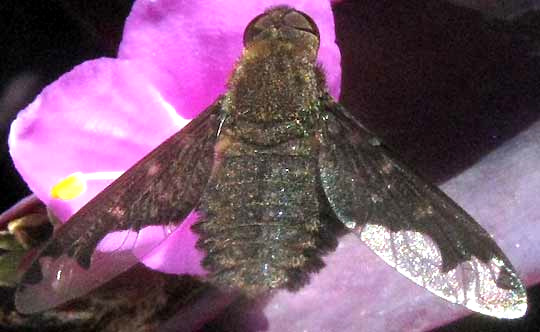Excerpts from Jim Conrad's
Naturalist Newsletter

from the October 13, 2013 Newsletter issued from the Frio Canyon Nature Education Center in the valley of the Dry Frio River in northern Uvalde County, southwestern Texas, on the southern border of the Edwards Plateau; elevation ~1750m (~5750 ft); N29.62°, W99.86°; USA
BEE FLY
Each morning several honeybees visit the flowering Purple Spiderwort on Juniper House's deck, gathering pollen. Only occasionally do bee flies come. Above, you can see one hovering at the edge of a flower, probing a pollen-filled yellow anther with his clublike, sponging-type proboscis, and his wings moving so fast that they appear only as blurs. The same fly at rest, displaying distinctive, partially pigmented wings, is shown below:

Volunteer identifier Bea in Ontario feels that probably we have the Sinuous Bee Fly, sometimes called the Chocolate Bee Fly, HEMIPENTHES SINUOSA. That's a common species throughout most of North America, but Bea says so many species are recognized that she can't be perfectly sure of the ID. The design created by the pigmentation on our fly's wings so perfectly matches those of the Sinuous Bee Fly that I'm filing this page under that name, knowing that eventually an expert will confirm or correct it. The important thing is to document the fly here at this time doing what it's doing.
You can see that this is a fly and not a bee, because bees have four wings, but flies like our critter have only two.
Bee flies of this genus are parasitoids and hyperparasitoids. Parasitoid species are those whose mode of life is intermediate between being a parasite and a predator. In this case it means that parasitoid bee fly larvae are parasitic on another species, but the adult visits flowers.
The term hyperparasitoid refers to the fact that our bee fly's larvae hatch within the larval stage (caterpillars) of tachinid flies, ichneumon wasps and other species, which themselves are parasitic in other species. In other words, larvae in this genus are parasites of parasites of other animals...